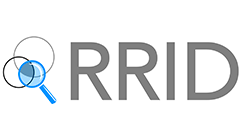Research Resource Identifiers (RRIDs)
Contract Number: 75N97021P00135
Research Emphasis/Objectives

The Research Resource Identifiers project, or RRID initiative, aims to promote research resource identification, discovery, and reuse. It helps solve the challenges of reproducibility, efficiency, and connectivity that result from researchers not being precise when citing biological resources. The initiative is based on a concept called an RRID, which is a persistent and unique identifier given to a biological resource. An RRID (example: RRID:MMRRC_031168-UCD) begins with “RRID” and includes other identifying information like the strain and source of the resource. Such a system serves the biomedical community to correctly report, accurately replicate, and more easily extend findings from animal research and allows resource distributors and funding agencies to monitor the use of these key model organisms and other resources.
Services Provided
The Resource Identification Portal community hosts a website (https://scicrunch.org/resources) that displays the proper citations for common research resources. Using this website, authors can find RRIDs by searching for the catalog number of their research resources, clicking on the “How to Cite” button, and copying and pasting the resulting text into their methods section. For resources that are generated de novo and are to be made available as a stable stock, authors are asked to deposit the organism with an appropriate stock center or at least register the information about the animal with the proper authority appropriate for the organism currently available in the Resource Identification Portal (https://scicrunch.org/resources/about/guidelines#organism). These model organism authorities will give authors the proper name and an identifier for the new resource that can then be used to construct its RRID. The portal offers a central location for finding a resource of interest or registering a resource for others to find. The portal relies on the work of many community repositories, such as Addgene, Mutant Mouse Resource and Research Centers, National Swine Resource and Research Center, Bloomington Drosophila Stock Center, and Zebrafish International Resource Center. These community databases are the source for RRIDs of their type. By labeling a research resource with an RRID, researchers can look up information about the resource, as well as find all publications that reference that RRID. This increases transparency in the scientific process and makes it easier to find, report, and track information about resources. A significant number of journals and publishers—including Nature, Cell, Science, and the American Association for Cancer Research—are encouraging the use of RRIDs by authors.
Contact Information
Anita Bandrowski, Ph.D.
SciCrunch
P.O. Box 928191
San Diego, CA 92192-8191
[email protected]
https://rrid.site



